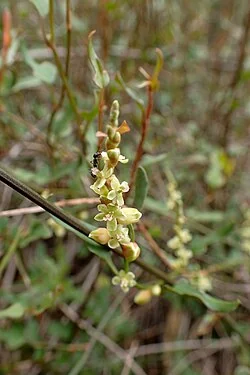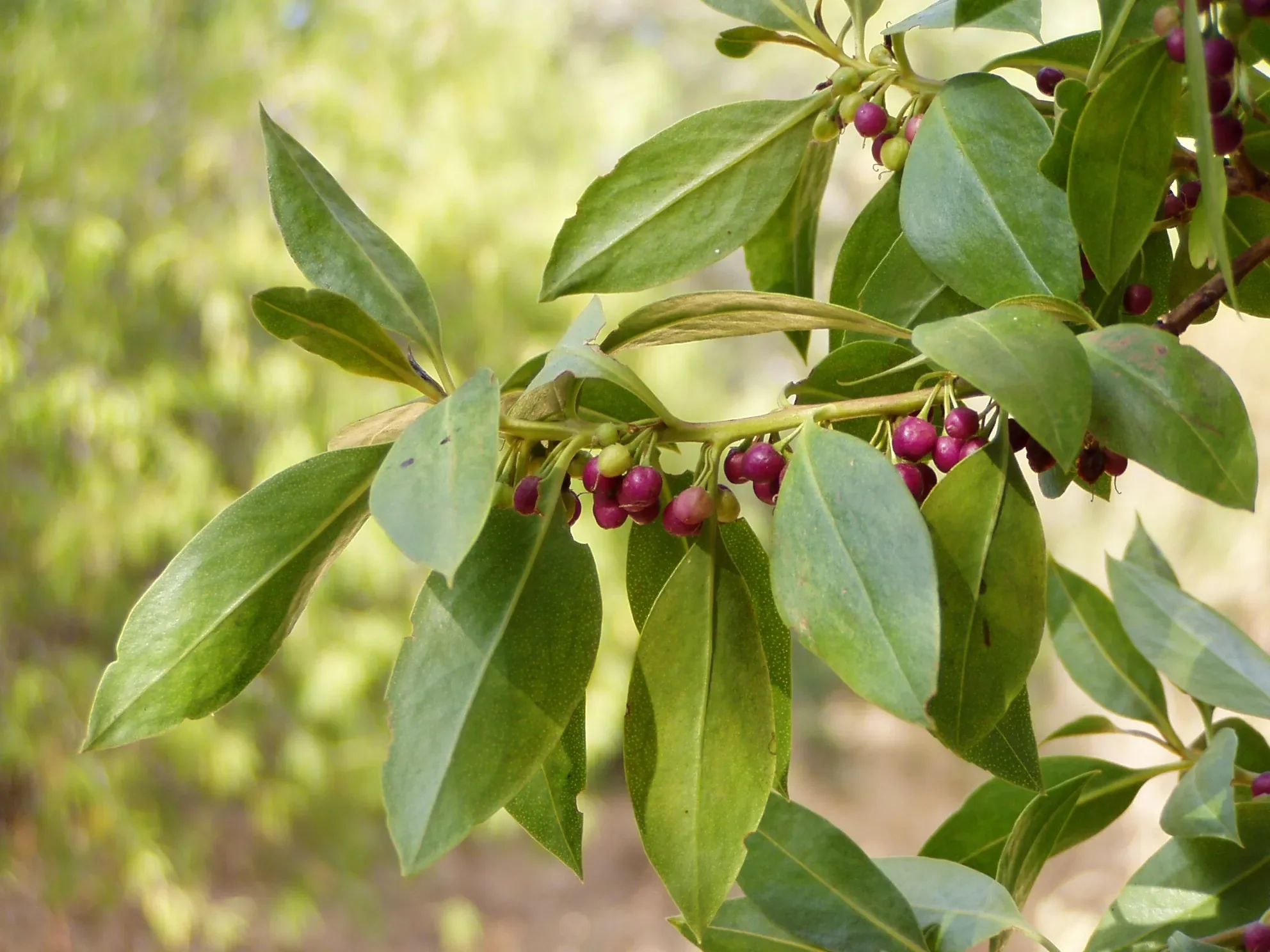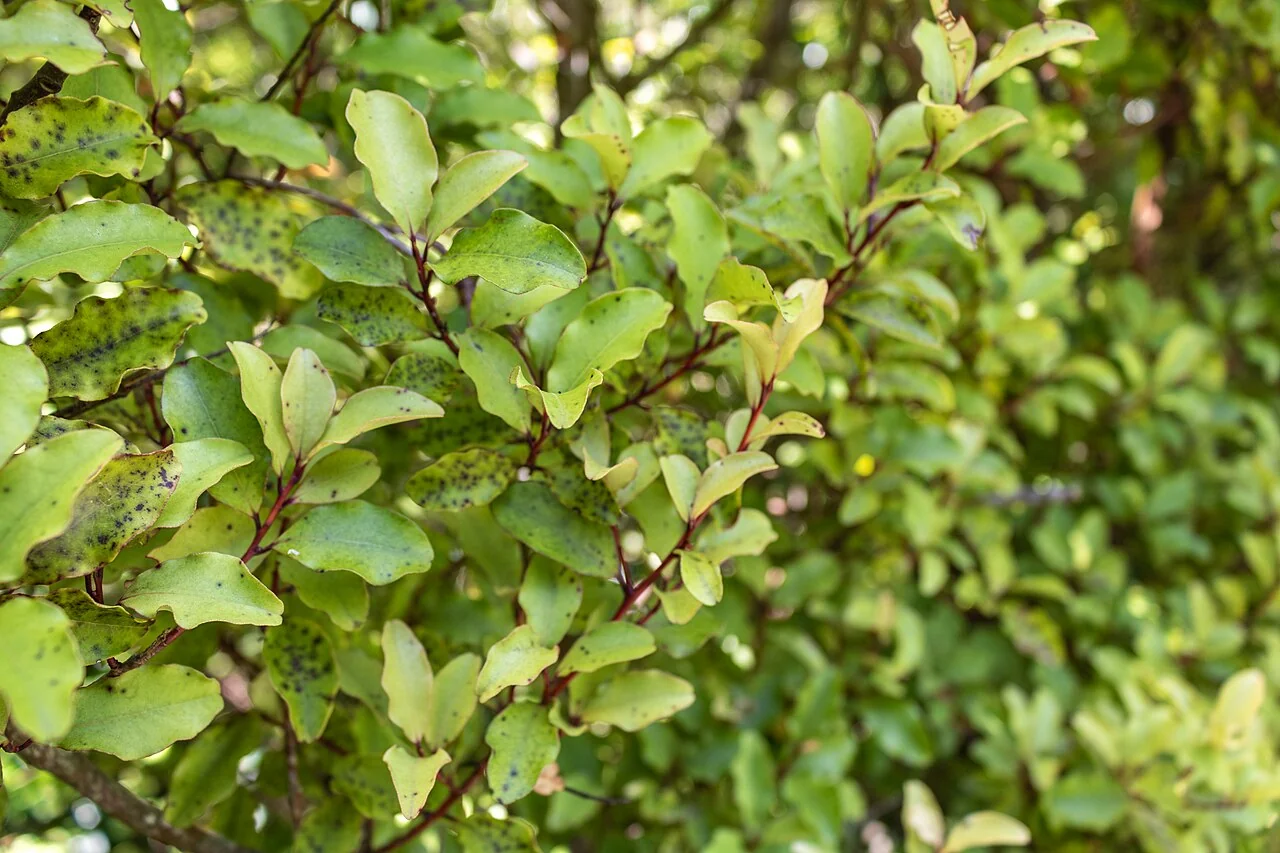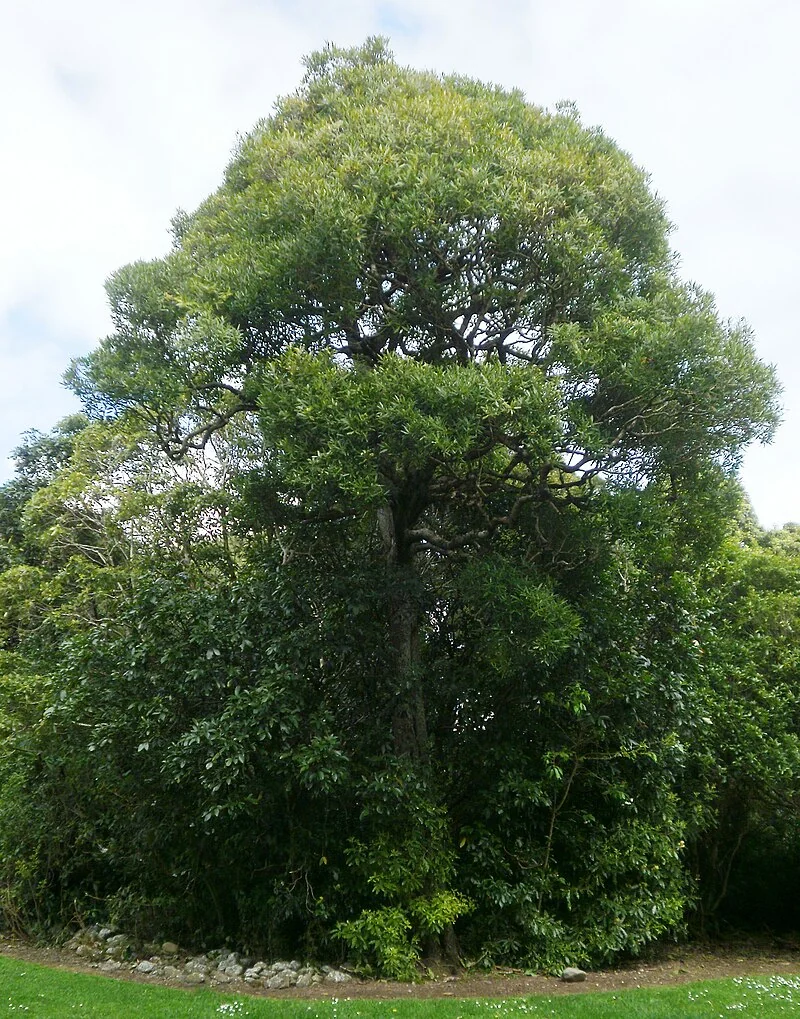
Leafless Pohuehue
Muehlenbeckia ephedroides
This native plant, known as Leafless pohuehue (scientific name: Muehlenbeckia ephedroides), is a remarkable species endemic to New Zealand. It is characterized by its unique features, ecological role, and cultural significance. This comprehensive guide provides detailed information on its care, propagation, and importance within the New Zealand ecosystem. Understanding this plant contributes to the appreciation of our rich biodiversity and heritage. native trees

Plant Description
Botanical Features
Leafless Pohuehue (Muehlenbeckia ephedroides) is a sprawling to prostrate, grey-green to grey-black shrub native to New Zealand. It forms dense, untidy mats up to 1.5 meters in diameter. Its stems are much branched, flexuous, striate, puberulent, and typically 1 mm in diameter. The leaves are narrow-linear, 5-25 mm long, dark to grey-green, often sparse, deciduous, and sometimes absent, contributing to its "leafless" appearance. It produces small, mostly unisexual flowers, appearing in fascicles or racemes with pale pedicels. The lobes are narrow-triangular and can be white, greenish, or pale yellow-green. The fruit is ovoid, trigonous, lustrous black, about 3 x 1.5 mm, with the tepals becoming swollen, white, and succulent. It thrives in coastal to subalpine environments, commonly found on river flats, beaches, sand spits, alluvial fans, and gravelly soils.
Quick Facts
| Scientific Name | Muehlenbeckia ephedroides |
|---|---|
| Height | 15-20 m |
| Spread | 3-5 m |
| Water Needs | Moderate |
| Light | Full sun to part shade |
| Frost Tolerance | Moderate |
| Salt Tolerance | Moderate |
| Growth Rate | Medium |
| Lifespan | Long |
Climate Best Suited to
Leafless pohuehue (Muehlenbeckia ephedroides) is primarily found in lowland to hilly forests across the North Island of New Zealand, extending to the Marlborough Sounds in the South Island. It demonstrates good adaptability to various conditions, thriving in areas with well-drained soils and tolerating both full sun and partial shade. Its natural distribution suggests a preference for warmer, more humid environments but with a reasonable tolerance for cooler temperatures found in its southern range.
Regional Suitability
| City | Climate Suitability |
|---|---|
| Whangārei | Ideal |
| Auckland | Ideal |
| Hamilton | Ideal |
| Tauranga | Ideal |
| Rotorua | Ideal |
| Gisborne | Ideal |
| New Plymouth | Ideal |
| Napier | Ideal |
| Whanganui | Ideal |
| Palmerston North | Ideal |
| Wellington | Ideal |
| Nelson | Ideal |
| Christchurch | Ideal |
| Dunedin | Moderate |
| Invercargill | Moderate |
Natural Habitat
Leafless PÂ huehue is a plant of open, dry, and often harsh environments. It is typically found on river flats, beaches, sand spits, and alluvial fans, often in gravelly or sandy soils. It is a pioneer plant, colonising disturbed ground, and is tolerant of drought and a wide range of temperatures.
Plant Conservation
Muehlenbeckia ephedroides, a native New Zealand plant, is facing conservation challenges, with its status officially listed as "Declining" in the wild. In 2017, it was categorized as "At Risk - Declining," and by 2023, its conservation status was elevated to "Threatened - Nationally Vulnerable." This sprawling to prostrate shrub is most prevalent in the north-eastern South Island of New Zealand. However, it is severely threatened in the North Island, where it is believed to be extinct around Lake Taupo, with only small, scattered populations remaining in areas like Hawke's Bay, southern Wairarapa, and the south Wellington coastline. While more widespread in the South Island, it is still rarely common. Muehlenbeckia ephedroides thrives in coastal to subalpine environments, typically found on river flats, beaches, sand spits, alluvial fans, outwash gravels, and river terraces. It prefers open, dry, free-draining, and fertile sites, often on gravel and sandy soils, where it faces less competition from taller plants. The primary threat to this species stems from its habitat preference, as these areas are frequently subjected to human activities and pressure. Beyond its ecological significance as a host plant for native copper butterflies, Muehlenbeckia ephedroides is also valued for its use in erosion control and habitat restoration due to its ability to stabilize soil.
Growing Requirements
Soil Requirements
Leafless pohuehue (Muehlenbeckia ephedroides) is remarkably adaptable to different soil conditions, thriving in well-drained environments. It can tolerate a variety of soil types, from sandy to loamy, and prefers a neutral to slightly acidic pH. Good drainage is crucial to prevent root rot, ensuring healthy growth and development.
- Tolerates a wide range of soil types from clay to sandy
- Prefers well-draining soils but can handle occasional waterlogging
- Thrives in moderately fertile soils but will grow in poor soils too
- Can tolerate slightly acidic to slightly alkaline pH
- Handles coastal conditions including salt spray
Light Requirements
Leafless pohuehue (Muehlenbeckia ephedroides) thrives in a variety of light conditions, from full sun to partial shade. Optimal growth and flowering are typically achieved in locations receiving ample sunlight throughout the day. However, it can also tolerate some shade, especially in hotter climates, where it benefits from protection during the most intense afternoon sun.
- Full sun for optimal growth and form
- Can tolerate partial shade but may develop a leggier form
- At least 6 hours of direct sunlight daily is ideal
- Northern or eastern exposures work well in garden settings
Water Requirements
Once established, Leafless pohuehue (Muehlenbeckia ephedroides) is remarkably drought-tolerant, requiring minimal supplemental watering. During its establishment phase, consistent moisture is crucial to encourage strong root development. Mature plants can withstand dry periods, but regular watering during prolonged droughts will promote healthier growth and more abundant flowering.
- Moderate watering during establishment (first 1-2 years)
- Drought-tolerant once established
- Can handle periods of soil saturation
- Reduce watering in winter when growth slows
- Signs of overwatering include yellowing leaves and crown rot
Planting Guide
1. Ideal Growing Conditions:
- Sun Exposure: Muehlenbeckia ephedroides thrives in full sun to mostly sun conditions. While some Muehlenbeckia species can tolerate partial shade, full sun generally promotes the best growth.
- Soil Needs: This plant prefers average, gritty, and well-drained soil. Sandy, stony, or light loam is ideal. It's crucial to avoid heavy, waterlogged soils, which can lead to root issues.
- Watering: Once established, Muehlenbeckia ephedroides is highly drought-tolerant and requires low to occasional watering. During its first season, water regularly to encourage strong root growth.
- Hardiness: It is suitable for USDA Zones 7b - 10b.
- Resistance: The plant is resistant to deer and heat, and highly tolerant of wind and salt spray, making it an excellent choice for coastal sites.
2. Planting:
- When to Plant: The best time to plant Muehlenbeckia is between spring and autumn.
- How to Plant: Dig a planting hole that is at least 50-75% deeper and wider than the plant's root ball. Mix compost into your existing soil at a 50/50 ratio. Backfill the hole so that the top of the plant's roots are level with the surrounding ground. Gently firm the soil and water in well.
Ecological Role
Leafless p� huehue (Muehlenbeckia ephedroides) forms wiry, prostrate mats on dunes, shingle fans and dry river terraces. These tough mats knit loose substrates, slow wind at the surface and trap drifting sand and organic litter. The tiny, nectarâbearing flowers draw small insects; berries are taken opportunistically by lizards and birds, spreading seed along coasts and braided rivers. Its low, open tangle creates warm microârefugia used by invertebrates and skinks in exposed sites.
- Dune/braid stabiliser: Binds mobile sands and gravels, reducing erosion and surface scour.
- Faunal support: Provides nectar for insects and cover and fruit for small reptiles and birds.
- Stress tolerance: Endures salt spray, drought and heat, contributing structure where few plants persist.
Uses and Significance
Garden Uses
- Specimen tree for visual impact
- Suitable for native gardens and restoration projects
- Enhances native garden aesthetics and biodiversity
- Provides architectural accent with its unique structure
- Effective for erosion control on slopes and banks
Landscaping Ideas
Coastal Groundcover
- Dunes and banks: Excellent mat-forming cover for sunny, sandy, or gravelly slopes.
- Rock gardens: Weaves among stones and boulders, softening edges with wiry, leafless stems.
- Coastal courtyards: Tolerates salt spray and heat once established.
Keep soils lean and well-drained; excessive fertility encourages floppy growth. Occasional trimming maintains a tight, tidy mat.
Seasonal Care Calendar
Spring
In spring, Leafless pohuehue (Muehlenbeckia ephedroides) begins its active growth phase. New foliage emerges, and it's an ideal time for planting new specimens or propagating. Ensure adequate moisture and monitor for early signs of pests.
- New growth begins with fresh foliage development
- Apply a balanced, slow-release fertilizer if desired
- Excellent time for planting new specimens or dividing offsets
- Monitor for new pest activity and address promptly
Summer
Summer is the peak growing season for Leafless pohuehue (Muehlenbeckia ephedroides), often accompanied by flowering. Consistent watering is important, especially for young plants, to support vigorous growth and prevent stress during dry periods.
- Flowering typically occurs in early to mid-summer (November-January)
- Water young trees regularly during extended dry periods
- Avoid heavy pruning during the active growing season
Autumn
During autumn, Leafless pohuehue (Muehlenbeckia ephedroides) prepares for the cooler months. Fruits or berries develop, providing food for native birds. It's also a good time for planting and general garden cleanup.
- Fruits or berries develop and ripen (December-February), attracting birds
- Natural leaf shedding occurs as part of its growth cycle
- Good time for planting new specimens to establish before winter
- Clean up fallen leaves if a tidy appearance is desired
Winter
Winter is generally a dormant period for Leafless pohuehue (Muehlenbeckia ephedroides). Minimal care is required, though young plants may benefit from protection in colder regions. This is an opportune time for any necessary structural pruning.
- Generally dormant with minimal growth activity
- No special winter protection needed in most mild climates
- Suitable time for structural pruning if required
- Fallen leaves can be left as mulch or removed for tidiness
When to Prune and How Much
Leafless pohuehue (Muehlenbeckia ephedroides) generally requires minimal pruning to maintain its natural form and health. Pruning should focus on removing dead or damaged growth and shaping the plant as needed.
- Remove dead, damaged, or diseased branches at any time of year
- Light formative pruning when young helps establish good structure
- To create a multi-trunked specimen, cut the main stem to encourage branching
- Fallen leaves can be removed for a tidier appearance, or left as natural mulch
- If necessary, lower branches can be removed to create clearance underneath
- Major pruning is best done in late winter to early spring before new growth
Always use clean, sharp tools for pruning to minimize the risk of disease and ensure clean cuts. The plant often responds well to pruning with vigorous new growth, contributing to a fuller, healthier appearance.
How to Grow Leafless Pohuehue
From Seed
Propagating Leafless pohuehue (Muehlenbeckia ephedroides) from seed is a rewarding process, though it requires patience. Start by collecting seeds from the ripe, dark berries in autumn. Clean the flesh from the seeds before sowing. Sow the seeds in a deep seed tray filled with a well-draining seed-raising mix. Cover them lightly with about 5mm of the mix or fine gravel. Water the tray gently and place it in a warm, sheltered spot with bright, indirect sunlight. Germination can be slow, taking several months. It is crucial to maintain consistent moisture levels without waterlogging the soil. Once the seedlings are large enough to handle, carefully prick them out into individual pots. Use a deep pot to accommodate the plant's developing taproot. Grow them on for a year or two before planting them in their final position.
From Cuttings
Leafless pohuehue can also be grown from semi-hardwood cuttings, which is a faster method than growing from seed and ensures the new plant is true to the parent. Take cuttings in late summer or early autumn from healthy, vigorous shoots of the current season's growth. Cuttings should be about 10-15cm long and taken from a node. Remove the leaves from the lower half of the cutting to reduce water loss and dip the base in a rooting hormone to encourage root development. Insert the cuttings into a container filled with a free-draining potting mix. Place the container in a warm, humid environment, like a propagator or under a clear plastic bag, to maintain high humidity. Keep the mix moist but not waterlogged. Roots should form within a few months. Once the cuttings have a well-developed root system, they can be potted on into larger containers and grown until they are robust enough to be planted out in the garden.
Planting
When planting your Leafless pohuehue, choose a site with well-drained soil and a sunny or partially shaded aspect. While it is adaptable to a range of conditions, it thrives in a cooler, moist root run. Before planting, prepare the site by digging a hole that is twice the width of the root ball and just as deep. Gently tease out the roots of the plant and place it in the hole, ensuring that it is at the same depth as it was in the pot. Backfill with soil and firm it down gently. Water the plant thoroughly after planting to settle the soil and eliminate any air pockets. It is important to keep the soil moist, especially during dry periods, until the plant is well-established. Applying a layer of organic mulch around the base of the plant will help to retain moisture, suppress weeds, and provide nutrients as it breaks down.
Pests and Diseases
Low-Maintenance, Dry-Land Species
- Root rot: Overwatering or heavy soils cause decline; ensure fast drainage.
- Aphids/mealybugs: Occasionally on tender tips; rinse off or spot-treat.
- Spider mites: In very hot, dry sites; hose down foliage to increase humidity temporarily.
- Browsing: Protect young plants from rabbits/hares until established.
Cultural Significance
Muehlenbeckia ephedroides, also known as leafless pohuehue, is a plant native to New Zealand. While it is recognized as a unique component of New Zealand's native flora, extensive specific cultural significance is not widely documented in terms of traditional uses by indigenous peoples, symbolic meanings, or its role in folklore or art.
Its ecological role in stabilizing banks and erodible areas, particularly in coastal and riverine environments, contributes to its natural heritage value. Its distinctive growth habit and resilience in harsh conditions are appreciated in horticultural contexts.
Bonus Tip
Leafless p huehue (Muehlenbeckia ephedroides) thrives on poor, sandy, or gravelly soils. If it becomes too vigorous, reduce irrigation rather than pruning hard - light summer water stress tightens internodes and keeps the mat dense and tidy without sacrificing flowering and fruiting for native butterflies and lizards.







